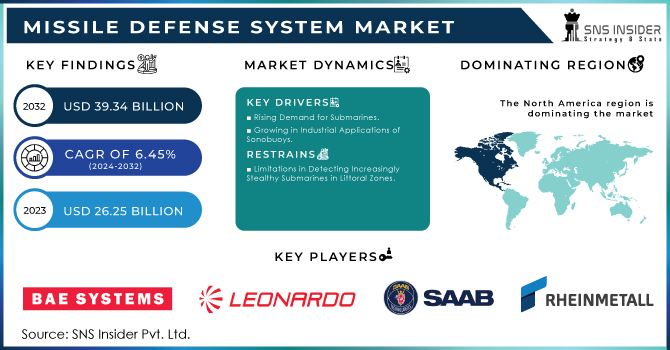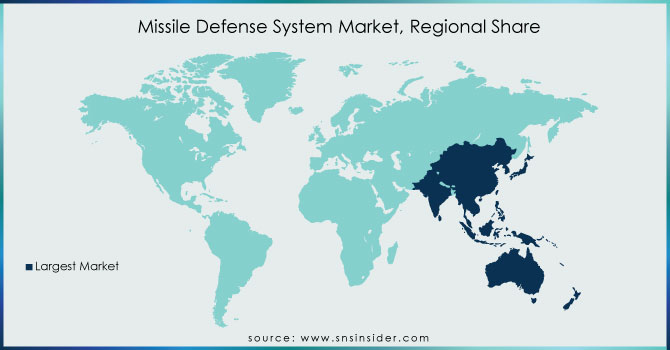Missile Defense System Market Report Scope & Overview:

To get more information on Missile Defense System Market - Request Free Sample Report
The Missile Defense System Market Size was valued at USD 26.25 billion in 2023 and is expected to reach USD 39.34 billion by 2032 and grow at a CAGR of 4.6% over the forecast period 2024-2032.
The expression & quote Missile Defense System" extensively implies a framework that gives any guard against any missile type (traditional or atomic) by any country. Any instrument that can distinguish and afterward annihilate a rocket before it can inflict any kind of damage is known as a Missile Defense System (MDS). The Missile Defense System incorporates land and marine-based innovations utilized by the protection powers to make preparations for an assortment of missiles, including voyage and long-range missiles. In the midst of a rise in clashes and war-like circumstances across various areas of the planet, the interest in the Missile Defense System has developed at a huge rate. The Missile Defense System guarantees the security of public resources and residents against missile assaults. Because of the expanded military spending by created and created economies across the world, missile innovation is seeing quick development. In this manner, it becomes essential for countries to protect their ground resources like ordered army installations, and so forth from an approaching missile danger. Moreover, expanding interests in Missile Defense systems by the states of a few nations, like India, the US, and China, Saudi Arabia, among others are likewise expected to offer learning experiences for the market player.
MARKET DYNAMICS
KEY DRIVERS
-
Growing demand for the battlespace
-
Enhanced missile technology
-
Rising geopolitical instabilities
RESTRAINTS
-
Increasing cost
OPPORTUNITIES
-
Blooming New-generation missiles
-
Forming Nuclear-capable ballistic missiles
-
Advancing weapon capabilities
CHALLENGES
-
Inability to intercept threats
-
Boost-phase intercept capabilities
-
Counter a missile threat
THE IMPACT OF COVID-19
The impact of COVID-19 on the missile Defense system industry is uncertain, and it is likely to be in effect for a few years.
The COVID-19 outbreak compelled governments throughout the world to impose strict lockdowns and restrict the import-export of raw materials for the majority of 2020 and a few months in 2021. This resulted in a rapid decrease in the availability of critical raw materials used in the manufacture of ground defense equipment. Furthermore, the countrywide lockdown compelled component manufacturing plants to shut down partially or fully.
The negative effects of the COVID-19 epidemic have caused widespread delays in actions and projects aimed at developing contemporary missile defense systems.
Competitive Landscape
The ground-based Aircraft and Missile Defense Systems Market is integrated, with major players, such as Lockheed Martin Corporation, Israel Aerospace Industries, Raytheon Technologies Corporation, Thales Group, and Boeing Company, which owns the market.
Many key players adopt automatic production to speed up the production of aircraft and parts of the arrow protection system. Raytheon Technologies Corporation uses robots to generate LTAMDS radar for airborne and missile systems, such as the Patriot, quickly.
Market players also focus on working together to increase productivity and facilitate the flow of technology and knowledge. Boeing, Raytheon, and Lockheed Martin are reportedly working with the US Missile Defense Agency (MDA) to develop future Multi-Object Kill Vehicle (MOKV) technology to protect ballistic missiles.
KEY MARKET SEGMENTATION
By Range
-
Less than 100Km
-
101-200Km
-
201-400Km
By Domain
-
Ground
-
Marine
By Technology
-
Fire Control System
-
Weapon System
-
Countermeasure System
-
Command & Control System
By Threat Type
-
Subsonic Missiles
-
Supersonic Missiles
-
Hypersonic Missiles
REGIONAL ANALYSIS
Asia-Pacific is expected to lead part of the arrow defense programs between 2024 and 2022. In the Asia-Pacific region, ongoing MDS procurement programs in countries such as India, Australia, and China are responsible for partial growth. During the forecast period, the growth of the MDS component in India will be driven by the purchase of an S-400 medium-range surface-to-air missile system, as well as a short-range launch in the short-range.
In the Asia-Pacific region, important plans for the acquisition of arrows in countries such as India, Taiwan, Australia, and Japan are responsible for partial growth. In December 2022, Taiwan announced plans to purchase 300 Patriot Advanced Capability 3, missiles worth $ 6 billion in the US. Throughout 2022-2028, the US will invest heavily in the North American missile market. Investment during the forecast period is due to SSN-related benefits compared to more powerful submarines.

Need any customization research on Missile Defense System Market - Enquiry Now
REGIONAL COVERAGE
North America
-
USA
-
Canada
-
Mexico
Europe
-
Germany
-
UK
-
France
-
Italy
-
Spain
-
The Netherlands
-
Rest of Europe
Asia-Pacific
-
Japan
-
South Korea
-
China
-
India
-
Australia
-
Rest of Asia-Pacific
The Middle East & Africa
-
Israel
-
UAE
-
South Africa
-
Rest of Middle East & Africa
Latin America
-
Brazil
-
Argentina
-
Rest of Latin America
KEY PLAYERS
The leading players in the Global Missile Defense System Market are BAE System, Leonardo S.p. A, Saab AB, IAI, Lockheed Martin Corporation, Rheinmetall AG, Thales Group, Raytheon Technologies Corporation, MBDA, KONGSBERG, Northrop Grumman Corporation, ASELSAN A.S, and other players.
| Report Attributes | Details |
|---|---|
| Market Size in 2023 | USD 26.25 Billion |
| Market Size by 2032 | USD 39.34 Billion |
| CAGR | CAGR 4.6% From 2024 to 2032 |
| Base Year | 2023 |
| Forecast Period | 2024-2032 |
| Historical Data | 2021-2022 |
| Report Scope & Coverage | Market Size, Segments Analysis, Competitive Landscape, Regional Analysis, DROC & SWOT Analysis, Forecast Outlook |
| Key Segments | • by Technology (Fire Control System, Weapon System, Countermeasure System, and Command and Control System) • by Range (Short, Medium, and Long) • by Threat type • by Domain (Ground, Air, Marine, and Space) |
| Regional Analysis/Coverage | North America (USA, Canada, Mexico), Europe (Germany, UK, France, Italy, Spain, Netherlands, Rest of Europe), Asia-Pacific (Japan, South Korea, China, India, Australia, Rest of Asia-Pacific), The Middle East & Africa (Israel, +D11UAE, South Africa, Rest of Middle East & Africa), Latin America (Brazil, Argentina, Rest of Latin America) |
| Company Profiles | BAE System, Leonardo S.p. A, Saab AB, IAI, Lockheed Martin Corporation, Rheinmetall AG, Thales Group, Raytheon Technologies Corporation, MBDA, KONGSBERG, Northrop Grumman Corporation, ASELSAN A.S, and other players. |
| Key Drivers | •Growing demand for the battlespace. •Enhanced missile technology. •Rising geopolitical instabilities |
| Market OPPORTUNITIES: | •Blooming New-generation missiles. •Forming Nuclear-capable ballistic missiles •Advancing weapon capabilities. |

